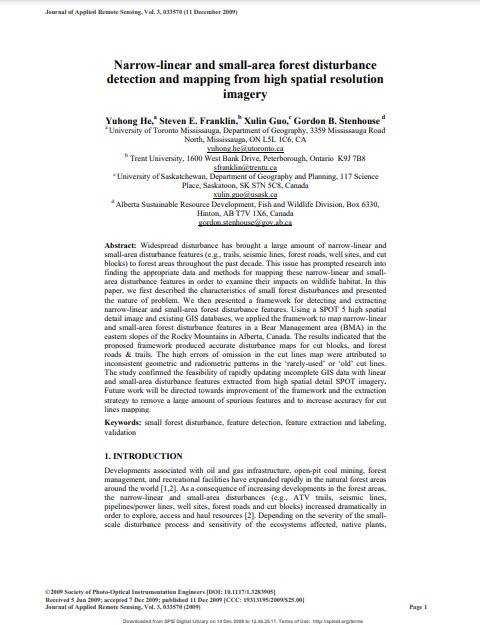Narrow-Linear and small-area forest disturbance detection and mapping from high spatial resolution imagery
Bosque Modelo:
Foothills
Temática:
Gestión forestal
Tipo de documento:
Artículo científico
Resumen
Widespread disturbance has brought a large amount of narrow-linear and
small-area disturbance features (e.g., trails, seismic lines, forest roads, well sites, and cut blocks) to forest areas throughout the past decade. This issue has prompted research into finding the appropriate data and methods for mapping these narrow-linear and smallarea disturbance features in order to examine their impacts on wildlife habitat. In this paper, we first described the characteristics of small forest disturbances and presented the nature of problem. We then presented a framework for detecting and extracting narrow-linear and small-area forest disturbance features. Using a SPOT 5 high spatial detail image and existing GIS databases, we applied the framework to map narrow-linear and small-area forest disturbance features in a Bear Management area (BMA) in the eastern slopes of the Rocky Mountains in Alberta, Canada. The results indicated that the proposed framework produced accurate disturbance maps for cut blocks, and forest roads & trails. The high errors of omission in the cut lines map were attributed to inconsistent geometric and radiometric patterns in the ‘rarely-used’ or ‘old’ cut lines. The study confirmed the feasibility of rapidly updating incomplete GIS data with linear and small-area disturbance features extracted from high spatial detail SPOT imagery. Future work will be directed towards improvement of the framework and the extraction strategy to remove a large amount of spurious features and to increase accuracy for cut lines mapping
Información Bibliográfica
Autor:
He, Y., Franklin, S.E., Guo, X., & Stenhouse, G.B.
Revista:
Journal of Applied Remote Sensing
Año:
2009
N°:
-
País :
Canadá
Páginas:
-
Volumen:
3
Idioma:
Ingles
Palabras claves
small forest disturbance, feature detection, feature extraction and labeling, validation





